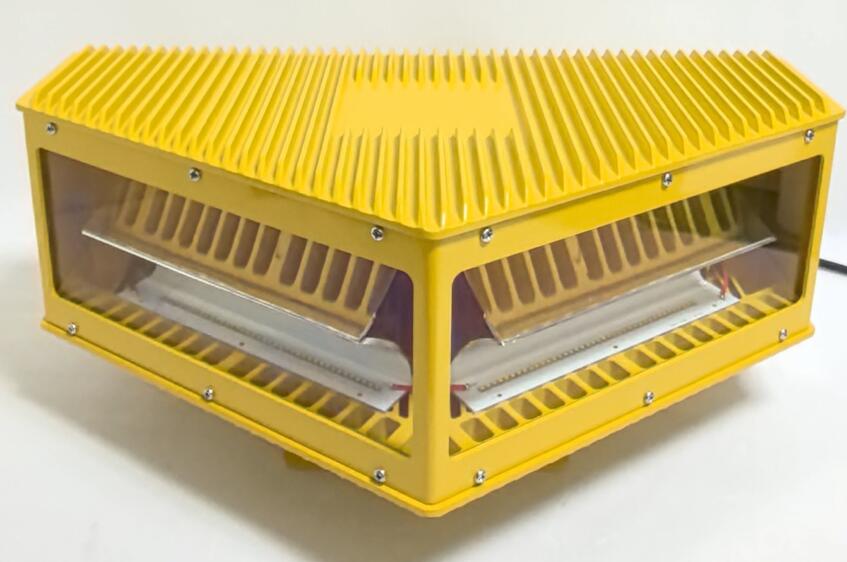Chimney Aircraft Warning Lights: Essential Guardians for Industrial Airspace Safety
As industrial facilities continue to expand vertically, chimney aircraft warning lights have become critical components in aviation safety systems. These specialized lighting solutions ensure tall smokestacks and industrial chimneys remain visible to low-flying aircraft, preventing potential collisions. This article examines the unique requirements, technological features, and regulatory standards that make these warning systems indispensable for modern industrial infrastructure.
The Critical Role of Chimney Warning Systems
Industrial chimneys present unique challenges for aviation safety due to:
Their extreme heights (often exceeding 500 feet)
Frequent location near airports or flight paths

Potential to blend into night skies or foggy conditions
Chimney aircraft warning lights address these concerns by:
Providing 360-degree visibility for approaching aircraft
| chimney aircraft warning light |
Maintaining operation in harsh industrial environments
Complying with international aviation regulations
Specialized Design Considerations
Unlike standard obstruction lighting, chimney aircraft warning lights require:
| chimney aircraft warning lights |
1. Extreme Durability
High-temperature resistant materials
Corrosion-proof coatings for chemical exposure
Vibration-resistant mounting systems
2. Enhanced Visibility Features
High-intensity LED arrays for maximum luminosity
Dual-color systems (red/white) for different altitude zones
Fail-safe redundancy systems
3. Unique Mounting Solutions
Curved surface adapters for tapered chimneys
Heat deflection shields
Easy-access maintenance platforms
Regulatory Compliance Framework
Chimney aircraft warning lights must meet stringent requirements:
1. Height-Based Standards
FAA L-810 for structures under 150 feet
L-864 for medium-height chimneys (150-500 feet)
L-865 for super-tall industrial stacks (500+ feet)
2. Industry-Specific Mandates
EPA visibility requirements for continuous operation
Local airspace authority specifications
International Civil Aviation Organization (ICAO) Annex 14
3. Performance Certifications
IP66/67 weatherproof ratings
ATEX certification for explosive atmospheres
MIL-STD-810G shock/vibration testing
Technological Advancements
Modern chimney aircraft warning lights incorporate innovative features:
1. Smart Monitoring Systems
Remote performance diagnostics
Automated fault reporting
Predictive maintenance alerts
2. Adaptive Lighting Technology
Ambient light sensors for automatic intensity adjustment
Weather-responsive flash patterns
Synchronized multi-unit operation
3. Sustainable Solutions
Solar-hybrid power options
Energy-efficient LED configurations
Recyclable material construction
Installation and Maintenance Best Practices
Proper implementation requires:
1. Strategic Placement
Multiple light tiers for tall chimneys
Optimal spacing for visibility angles
Consideration of nearby structures
2. Specialized Installation
Hot-work permits for active chimneys
Non-intrusive mounting techniques
Certified industrial rope access teams
3. Maintenance Protocols
Regular photometric testing
Lens cleaning schedules
Component stress inspections
Emerging Trends and Future Developments
The industry is evolving with:
AI-Powered Predictive Systems - Machine learning for failure anticipation
Advanced Materials - Graphene coatings for enhanced durability
Integrated Radar Systems - Combined visual/electronic warning solutions
Chimney aircraft warning lights represent a specialized intersection of industrial infrastructure and aviation safety technology. Their unique design requirements, stringent compliance standards, and advanced technological features make them essential for protecting both aircraft and industrial facilities. As chimney structures continue to grow taller and airspace becomes more congested, these warning systems will play an increasingly vital role in global aviation safety.
By understanding the specific challenges and solutions associated with chimney lighting systems, facility managers can ensure their installations provide reliable, long-term protection while meeting all regulatory obligations. The future promises even smarter, more efficient solutions as technology continues to advance in this critical safety field.
